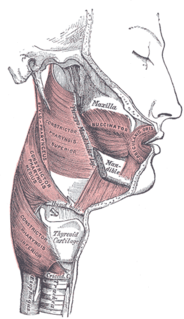
Cellulitis is a bacterial infection involving the inner layers of the skin. It specifically affects the dermis and subcutaneous fat. Signs and symptoms include an area of redness which increases in size over a few days. The borders of the area of redness are generally not sharp and the skin may be swollen. While the redness often turns white when pressure is applied, this is not always the case. The area of infection is usually painful. Lymphatic vessels may occasionally be involved, and the person may have a fever and feel tired.
Nocardiosis is an infectious disease affecting either the lungs or the whole body. It is due to infection by bacterium of the genus Nocardia, most commonly Nocardia asteroides or Nocardia brasiliensis.
Eosinophilic fasciitis, also known as "Shulman's syndrome", is a form of fasciitis, the inflammatory diseases that affect the fascia, the connective tissues surrounding muscles, blood vessels and nerves. Unlike other diseases in that category, it is limited to the arms and legs, and usually resolves itself, although some cases require corticosteroids, and some cases are associated with aplastic anemia.
ICD-10 is an international statistical classification used in health care and related industries.

Eosinophilic esophagitis, also known as allergic oesophagitis, is an allergic inflammatory condition of the esophagus that involves eosinophils, a type of white blood cell. Symptoms are swallowing difficulty, food impaction, vomiting, and heartburn.

Bacteroides fragilis is an obligately anaerobic, Gram-negative, rod-shaped bacterium. It is part of the normal microbiota of the human colon and is generally commensal, but can cause infection if displaced into the bloodstream or surrounding tissue following surgery, disease, or trauma.
A Brodie abscess is a subacute osteomyelitis, which may persist for years before converting to a frank osteomyelitis. Classically, this may present after conversion as a draining abscess extending from the tibia out through the skin. Occasionally acute osteomyelitis may be contained to a localized area and walled off by fibrous and granulation tissue. This is termed Brodie's abscess.

The buccal space is a fascial space of the head and neck. It is a potential space in the cheek, and is paired on each side. The buccal space is superficial to the buccinator muscle and deep to the platysma muscle and the skin. The buccal space is part of the subcutaneous space, which is continuous from head to toe.
Mepolizumab is a humanized monoclonal antibody used for the treatment of severe eosinophilic asthma. It recognizes and blocks interleukin-5 (IL-5), a signalling protein of the immune system.
Mycobacterium haemophilum is a species of the phylum Actinobacteria, belonging to the genus Mycobacterium.
Lateral internal sphincterotomy is an operation performed on the internal anal sphincter muscle for the treatment of chronic anal fissure. The internal anal sphincter is one of two muscles that comprise the anal sphincter which controls the passage of feces. The procedure helps by lowering the resting pressure of the internal anal sphincter, which improves blood supply to the fissure and allows faster healing. The procedure has been shown to be very effective, with 96% of fissures healing at a median of 3 weeks in one trial.
Quittor is an infection of the lower leg of equines, sometimes known as graveling. A condition once common in draft horses, it is characterized by inflammation of the cartilage of the lower leg. There are two forms, subcutaneous and cartilaginous. Quittor usually results from an injury to the leg, such as an abscess on the coronary band above the hoof, that allows foreign matter to get into the leg and then collect beneath the hoof, leading to an infection. In some cases, removing this matter requires cutting away parts of the hoof. Abscesses may also form inside the hoof capsule itself from improper shoeing and trimming of the hoof, from laminitis, or from injury to the sole of the hoof, but the horse will be significantly lame for a longer period of time if the infection migrates up to the coronary band rather than down. Treatment of hoof and coronary band abscesses today usually incorporates use of antibiotics, sometimes combined with poulticing.

A amoebic liver abscess is a type of liver abscess caused by amebiasis. It is the involvement of liver tissue by trophozoites of the organism Entamoeba histolytica and of is abscess due to necrosis.
Rapid growing mycobacterium consists of organism of the Mycobacterium fortuitum group and Mycobacterium chelonae/Mycobacterium abscessus group and these usually cause subcutaneous abscesses or cellulitis following trauma in immunocompetent patients.
Also called Zuska's disease, subareolar abscess is a subcutaneous abscess of the breast tissue beneath the areola of the nipple. It is a frequently aseptic inflammation and has been associated with squamous metaplasia of lactiferous ducts.

Sporothrix is a ubiquitous genus of soil-dwelling fungus discovered by Schenck in 1898 and studied in more detail by Hektoen and Perkins. The first described and best known species is Sporothrix schenckii, the causative agent of rose handler's disease. New environmental and pathogenic species have been discovered with the potential for more to be found as molecular techniques advance.
Cold abscess refers to an abscess that lacks the intense inflammation usually associated with infection. This may be associated with infections due to bacteria like tuberculosis and fungi like blastomycosis that do not tend to stimulate acute inflammation. Alternatively, cold abscesses are typical in persons with hyperimmunoglobulin E syndrome, even when infected with an organism like Staphylococcus aureus that causes abscesses with inflammation in others.








